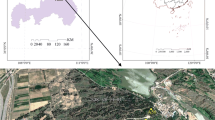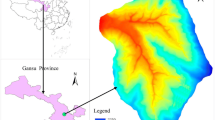Abstract
The arid and semi-arid northwestern China has been undergoing ecological degradation and the efforts to reverse the ecological degradation have been undertaken for many years. Some shifting dunes have been fixed and the vegetation has been partially recovered in certain areas and the Mu Us Sandy Land in the Ordos Plateau is an example of the success. The present study attempts to reveal the relationships between the vegetation restoration and ecohydrology in the Mu Us Sandy Land. We continuously measured soil water content at 10-min intervals under three vegetation types (i.e., shifting dune, shrub-dominated community, and herb-dominated community) in the Mu Us Sandy Land from April 2012 to October 2013. The results show the infiltration coefficient increased with increased rainfall amount and eventually reached a stable value. Infiltration coefficients were 0.91, 0.64, and 0.74 in the shifting dune, in the shrub-dominated community, and in the herb-dominated community, respectively. Cumulative infiltration and soil texture are two vital factors affecting the depths of rainfall penetration. Only rainfall events larger than 35.0 mm could recharge soil water at the 60–80 cm layer in the herb-dominated community. Our results imply that the expected forward succession of restored vegetation may be destined to deterioration after reaching the climax simply because of following two facts: (1) soil water is mainly retained at shallower layer and (2) plant fine roots mainly distribute in deeper layer in the herb-dominated community.
Similar content being viewed by others
References
Angelaki A, Sakellariou-Makrantonaki M, Tzimopoulos C. 2013. Theoretical and experimental research of cumulative infiltration. Transport in Porous Media, 100(2): 247–257.
Carlyle-Moses D E. 2004. Throughfall, stemflow, and canopy interception loss fluxes in a semi-arid Sierra Madre Oriental matorral community. Journal of Arid Environments, 58(2): 181–202.
Castellano M J, Valone T J. 2007. Livestock, soil compaction and water infiltration rate: evaluating a potential desertification recovery mechanism. Journal of Arid Environments, 71(1): 97–108.
Cheng X L, An S Q, Li B, et al. 2006. Summer rain pulse size and rainwater uptake by three dominant desert plants in a desertified grassland ecosystem in northwestern China. Plant Ecology, 184(1): 1–12.
Cobos D R, Chambers C. 2010. Calibrating ECH2O Soil Moisture Sensors, Application Note. Pullman, USA: Decagon Devices Inc., 1–7.
Guo K. 2000. Cyclic succession of Artemisia ordosica Krasch. community in the Mu Us Sandy grassland. Acta Phytoecologica Sinica, 24(2): 243–247. (in Chinese)
Hajiaghaei A, Rashidi M, Sadeghi M A, et al. 2014. Prediction of soil infiltration rate based on silt and clay content of soil. American-Euransian Journal of Agricultural & Environmental Science, 14(8): 702–706.
He Z B, Zhao W Z, Liu H, et al. 2012. The response of soil moisture to rainfall event size in subalpine grassland and meadows in a semi-arid mountain range: a case study in northwestern China’s Qilian Mountains. Journal of Hydrology, 420–421: 183–190.
Heisler-White J L, Knapp A K, Kelly E F. 2008. Increasing precipitation event size increases aboveground net primary productivity in a semi-arid grassland. Oecologia, 158(1): 129–140.
Lambers R, Rietkerk M, van den Bosch F, et al. 2001. Vegetation pattern formation in semi-arid grazing systems. Ecology, 82(1): 50–61.
Hudson B D. 1994. Soil organic matter and available water capacity. Journal of Soil and Water Conservation, 49(2): 189–194.
Jeddi K, Chaieb M. 2010. Changes in soil properties and vegetation following livestock grazing exclusion in degraded arid environments of South Tunisia. Flora—Morphology, Distribution, Functional Ecology of Plants, 205(3): 184–189.
Konwar J. 2016. Soil texture and total organic matter content and its influences on soil water holding capacity of Municipality soils of Moran in Sivasagar district of Assam, India. International Journal of Scientific Research, 5(1): 536–537.
Lebron I, Madsen M D, Chandler D G, et al. 2007. Ecohydrological controls on soil moisture and hydraulic conductivity within a pinyon-juniper woodland. Water Resources Research, 43(8): W08422, doi: 10.1029/2006WR005398.
Li X J, Li X R, Song W M, et al. 2008. Effects of crust and shrub patches on runoff, sedimentation, and related nutrient (C, N) redistribution in the desertified steppe zone of the Tengger Desert, Northern China. Geomorphology, 96(1–2): 221–232.
Li X R, Ma F Y, Xiao H L, et al. 2004. Long-term effects of revegetation on soil water content of sand dunes in arid region of Northern China. Journal of Arid Environments, 57(1): 1–16.
Li X R. 2005. Influence of variation of soil spatial heterogeneity on vegetation restoration. Science in China Series D: Earth Sciences, 48(1): 2020–2031.
Li X R, Kong D S, Tan H J, et al. 2007. Changes in soil and vegetation following stabilisation of dunes in the southeastern fringe of the Tengger Desert, China. Plant and Soil, 300(1–2): 221–231.
Li X R, Zhang Z S, Huang L, et al. 2013. Review of the ecohydrological processes and feedback mechanisms controlling sand-binding vegetation systems in sandy desert regions of China. Chinese Science Bulletin, 58(13): 1483–1496.
Li X Y, Zhang S Y, Peng H Y, et al. 2013. Soil water and temperature dynamics in shrub-encroached grasslands and climatic implications: results from Inner Mongolia Steppe ecosystem of north China. Agricultural and Forest Meteorology, 171–172: 20–30.
Liu G S. 1996. Soil Physical and Chemical Analysis & Description of Soil Profiles. Beijing: Standards Press of China, 38–39. (in Chinese)
Liu N, Zhou L H, Chen Y, et al. 2014. Identification and evaluation of desertification reversal in China: indicators and methods review. Sciences in Cold and Arid Regions, 6(3): 190–200.
Liu S G. 1997. A new model for the prediction of rainfall interception in forest canopies. Ecological Modelling, 99(2–3): 151–159.
Millennium Ecosystem Assessment. 2005. Ecosystems and Human Well-Being: Desertification Synthesis. Washington D.C.: World Resource Institute: 18–20.
Rietkerk M, van de Koppel J. 1997. Alternate stable states and threshold effects in semi-arid grazing systems. Oikos, 79(1): 69–76.
Sala O E, Lauenroth W K. 1982. Small rainfall events: an ecological role in semiarid regions. Oecologia, 53(3): 301–304.
Su Y Z, Li Y L, Cui J Y, et al. 2005. Influences of continuous grazing and livestock exclusion on soil properties in a degraded sandy grassland, Inner Mongolia, northern China. Catena, 59(3): 267–278.
van de Koppel J, Rietkerk M, Weissing F J. 1997. Catastrophic vegetation shifts and soil degradation in terrestrial grazing systems. Trends in Ecology & Evolution, 12(9): 352–356.
van de Koppel J, RietkerK M, Van Langevelde F, et al. 2002. Spatial heterogeneity and irreversible vegetation change in semiarid grazing systems. The American Naturalist, 159(2): 209–218.
van de Koppel J, Rietkerk M. 2004. Spatial interactions and resilience in arid ecosystems. The American Naturalist, 163(1): 113–121.
Walkley A, Black I A. 1934. An examination of the Degtjareff method for determining soil organic matter, and a proposed modification of the chromic acid titration method. Soil Science, 37(1): 29–38.
Wang Q S, Dong X J, Chen X D, et al. 1997. Study on some features of Artemisia ordosica community at the different successional stages. Acta Phytoecologica Sinica, 21(6): 531–538. (in Chinese)
Wang S, Fu B J, Gao G Y, et al. 2013. Responses of soil moisture in different land cover types to rainfall events in a re-vegetation catchment area of the Loess Plateau, China. Catena, 101: 122–128.
Wang T, Wu W, Xue X, et al. 2004. Spatial-temporal changes of sandy desertified land during last 5 decades in northern China. Acta Geographica Sinica, 59(2): 203–212. (in Chinese)
Wang X P, Li X R, Kang E S, et al. 2003. The infiltration and redistribution of precipitation in revegetated sand dunes in the Tengger Desert, Shapotou, China. Acta Ecologica Sinica, 23(6): 1234–1241. (in Chinese)
Wang X P, Kang E S, Zhang J G, et al. 2004. Comparison of interception loss in shrubby and sub-shrubby communities in the Tengger desert of northwest China. Journal of Glaciology and Geocryology, 26(1): 89–94. (in Chinese)
Wang X P, Li X R, Xiao H L, et al. 2007. Effects of surface characteristics on infiltration patterns in an arid shrub desert. Hydrological Processes, 21(1): 72–79.
Wang X P, Zhang Y F, Hu R, et al. 2012. Canopy storage capacity of xerophytic shrubs in Northwestern China. Journal of Hydrology, 454–455: 152–159.
Wilcox B P, Breshears D D, Turin H J. 2003. Hydraulic conductivity in a Piñon–juniper woodland. Soil Science Society of America Journal, 67(4): 1243–1249.
Yang X, Zhang K, Jia B, et al. 2005. Desertification assessment in China: an overview. Journal of Arid Environments, 63(2): 517–531.
Zhang H J, Wu B, Yang W B, et al. 2012. Soil moisture characteristics of Artemisia ordosica community at different succession stages in Mu Us Sandy Land. Journal of Desert Research, 32(6): 1597–1603. (in Chinese)
Zhang X S. 1994. Principles and optimal models for development of Maowusu Sandy grassland. Acta Phytoecologica Sinica, 18(1): 1–16. (in Chinese)
Zhang Z H, Li X Y, Jiang Z Y, et al. 2013. Changes in some soil properties induced by re-conversion of cropland into grassland in the semiarid steppe zone of Inner Mongolia, China. Plant and Soil, 373(1): 89–106.
Acknowledgments
This work was supported by the National Natural Science Foundation of China (41130640, 41321001, 31470402), the Program for Changjiang Scholars and Innovative Research Team in University (IRT1108), and the Fundamental Research Funds for the Central Universities (2012CXQT07).
Author information
Authors and Affiliations
Corresponding author
Rights and permissions
About this article
Cite this article
Yu, X., Huang, Y., Li, E. et al. Effects of vegetation types on soil water dynamics during vegetation restoration in the Mu Us Sandy Land, northwestern China. J. Arid Land 9, 188–199 (2017). https://doi.org/10.1007/s40333-017-0054-y
Received:
Revised:
Accepted:
Published:
Issue Date:
DOI: https://doi.org/10.1007/s40333-017-0054-y




